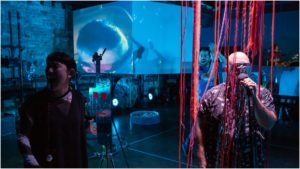
La MaMa 2019-20 Review: Object Collection’s ‘You Are Under Our Space Control’
An Overwhelming But Fascinating Opera Experiment
By Jennifer Pyron(photo credit: Hunter Canning)
La MaMa presented Object Collection’s utopian space-opera, “You Are Under Our Space Control” (YAUOSC) in an engrossing theatrical atmosphere that felt wildly predestined.
Founded in 2004 by writer/director Kara Feely and composer/musician Travis Just, Object Collection values accumulation above cohesion. The group seeks to radically inspire moments of innovative thought with dense layers of creativity and aesthetically pleasing processes formatted to push boundaries that rewire expectations.
Following a successful concert version of YAUOSC in London this past September which celebrated the vinyl/download/ streaming release of the sound track, Object Collection’s brilliant production at La MaMa proved exhilarating and catalytic.
The Music
Written and directed by Kara Feely and composed by Travis Just, YAUOSC featured a set designed by Peiyi Wong and lighting by Jeanette Yew. Performers mixed a panoply of objects, sounds, inventions, and unique ideas that webbed together an abstract story that cultivated a bizarre and enlivening synthesis seemingly apart from time.
Just’s musical composition was heavy laden with layers of drums that excited the listener and challenged connotations associated with the use of drum machines. His work expressed an air of coolness and delight through his combinations which were reminiscent of the initial excitement a child feels when first discovering drums.
Overall, he let go of what might have been traditionally expected and tuned into a playful flow of higher level brilliancy, thus evoking a theatrical sci-fi environment.
“For this piece, I and my main collaborator, Kara Feely thought we would approach this through the lens of experimental (whatever that means anymore!) art-making and histories of art-making. Also the social+political implications of those ways and cultures of making things,” said Just.
“As for how I got to the actual composing part – it was roundabout. I fooled around with transcribing some of Cage’s Music of Changes and seeing how it would be on drum machine – it was exciting! It just kind of spiraled from there, I kept transcribing MOC and kept generating material that was very malleable. I started applying it to bass synths, I cracked a DX7 emulator and made a bunch of ‘broken’ patches, all kinds of things. Sort of like a 13 year old let loose in a home studio without parental supervision. When all was said and done, every note of instrumental music was derived from this Cage piece,” Just added.
The Theater
The libretto was loosely based on various alchemical actions articulated and pieced together which allowed the audience to derive their own story. One might have felt like they were constantly being pulled to different areas on stage to witness individual facets of the performance.
However, it was best to put away weighed concentration and simply enjoy the limitlessness of the experience. The magical veil of childlike curiosity that encompassed the performance far outweighed the need to derive a clear synopsis.
Experimenting at a consistently progressive pace was key to what ultimately drove this opera forward. Costumes reflected prisms of color and the iridescent aesthetic conjured radical feelings and emotions throughout the opera. The color white especially evoked a sterile vibe when one performer put on white gloves to showcase materials of a previous performer’s creation. Highlighting the sense of loss one might feel when art is raised to a new level of display and adoration which becomes separated from the initial meaning behind the artist’s intention.
Every performer illuminated the relationship between art and the artist combined with text and the wordsmith. The libretto was a list of alchemic assignments combined with a dialogue fusion of Sun Ra’s Afrofuturist poetry, the Russian Cosmists’ poetics and philosophies, and interviews from astronauts, both real and imagined. Dense with material and activity on stage, the audience might have felt overwhelmed with stimulation.
And this was the point.
When the performers emulated extraterrestrials easing into the reality of their own bodies and sensations, lights became brighter, music became louder and it was a disoriented culmination of reactions. One might have felt challenged to question vibrational frequency and light wave pollution to the point in which they then questioned general reality and societal pollution.
One activity that particularly struck the audience was when two performers sat at a table and took turns describing a real person or an imaginary person. Next, they had to reveal whether they were real or imaginary and at the close of their reveal they repeated:
“I can feel who I am
I can feel who I am
I can feel who I am
I can feel who I am
I can feel who I am.”
Eventually, the humans expressed that earth was totally depleted of natural resources necessary to survive. It was time to leave. They abandoned fears and leapt into the unknown of space. YAUOSC’s imaginary sci-fi dreamscape was eerily on point with such topics and one might have felt the urge to follow Object Collection into the beyond.



